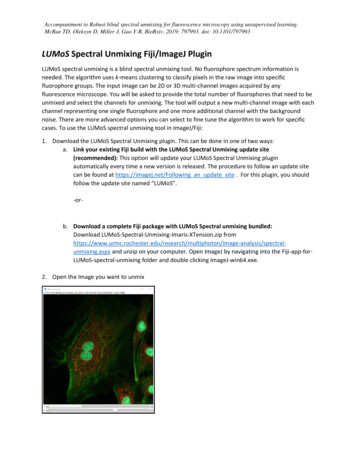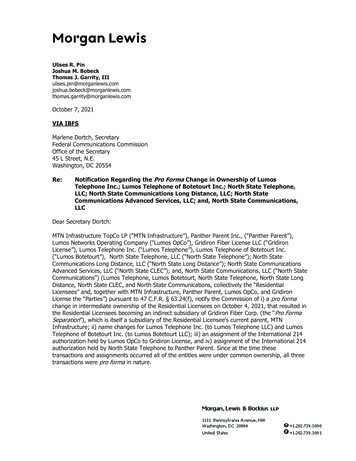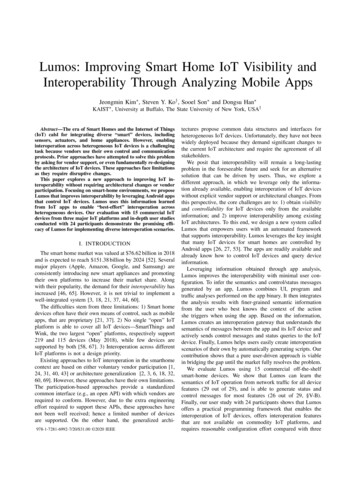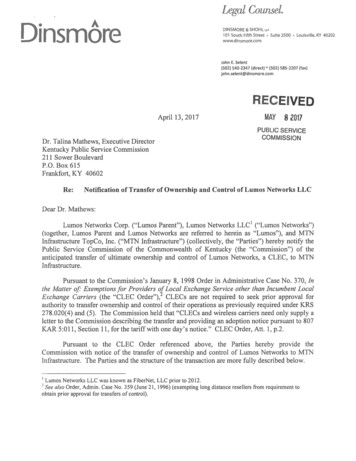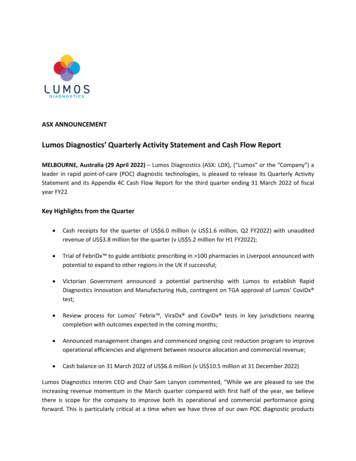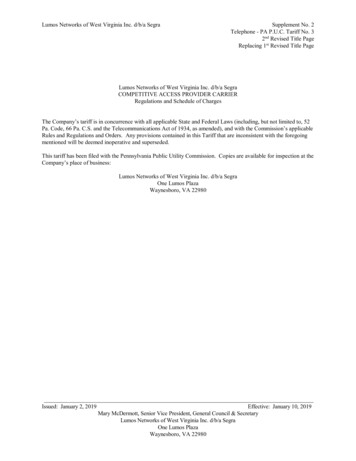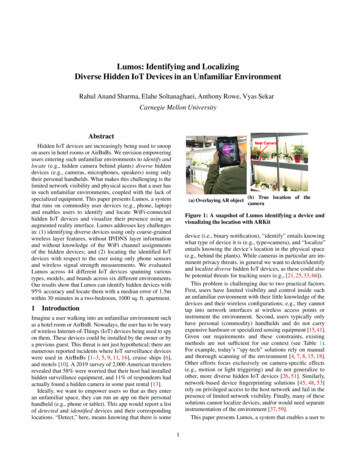
Transcription
Lumos: Identifying and LocalizingDiverse Hidden IoT Devices in an Unfamiliar EnvironmentRahul Anand Sharma, Elahe Soltanaghaei, Anthony Rowe, Vyas SekarCarnegie Mellon UniversityAbstractHidden IoT devices are increasingly being used to snoopon users in hotel rooms or AirBnBs. We envision empoweringusers entering such unfamiliar environments to identify andlocate (e.g., hidden camera behind plants) diverse hiddendevices (e.g., cameras, microphones, speakers) using onlytheir personal handhelds. What makes this challenging is thelimited network visibility and physical access that a user hasin such unfamiliar environments, coupled with the lack ofspecialized equipment. This paper presents Lumos, a systemthat runs on commodity user devices (e.g., phone, laptop)and enables users to identify and locate WiFi-connectedhidden IoT devices and visualize their presence using anaugmented reality interface. Lumos addresses key challengesin: (1) identifying diverse devices using only coarse-grainedwireless layer features, without IP/DNS layer informationand without knowledge of the WiFi channel assignmentsof the hidden devices; and (2) locating the identified IoTdevices with respect to the user using only phone sensorsand wireless signal strength measurements. We evaluatedLumos across 44 different IoT devices spanning varioustypes, models, and brands across six different environments.Our results show that Lumos can identify hidden devices with95% accuracy and locate them with a median error of 1.5mwithin 30 minutes in a two-bedroom, 1000 sq. ft. apartment.1(a) Overlaying AR object(b) True location of thecameraFigure 1: A snapshot of Lumos identifying a device andvisualizing the location with ARKitdevice (i.e., binary notification), “identify” entails knowingwhat type of device it is (e.g., type camera), and “localize”entails knowing the device’s location in the physical space(e.g., behind the plants). While cameras in particular are imminent privacy threats, in general we want to detect/identifyand localize diverse hidden IoT devices, as these could alsobe potential threats for tracking users (e.g., [21, 25, 33, 66]).This problem is challenging due to two practical factors.First, users have limited visibility and control inside suchan unfamiliar environment with their little knowledge of thedevices and their wireless configurations; e.g., they cannottap into network interfaces at wireless access points orinstrument the environment. Second, users typically onlyhave personal (commodity) handhelds and do not carryexpensive hardware or specialized sensing equipment [15,41].Given our requirements and these constraints, existingmethods are not sufficient for our context (see Table 1).For example, today’s “spy-tech” solutions rely on manualand thorough scanning of the environment [4, 7, 8, 15, 18].Other efforts focus exclusively on camera-specific effects(e.g., motion or light triggering) and do not generalize toother, more diverse hidden IoT devices [26, 51]. Similarly,network-based device fingerprinting solutions [45, 48, 53]rely on privileged access to the host network and fail in thepresence of limited network visibility. Finally, many of thesesolutions cannot localize devices, and/or would need separateinstrumentation of the environment [37, 59].This paper presents Lumos, a system that enables a user toIntroductionImagine a user walking into an unfamiliar environment suchas a hotel room or AirBnB. Nowadays, the user has to be waryof wireless Internet-of-Things (IoT) devices being used to spyon them. These devices could be installed by the owner or bya previous guest. This threat is not just hypothetical; there arenumerous reported incidents where IoT surveillance deviceswere used in AirBnBs [1–3, 5, 9, 11, 16], cruise ships [6],and motels [10]. A 2019 survey of 2,000 American travelersrevealed that 58% were worried that their host had installedhidden surveillance equipment, and 11% of respondents hadactually found a hidden camera in some past rental [13].Ideally, we want to empower users so that as they enteran unfamiliar space, they can run an app on their personalhandheld (e.g., phone or tablet). This app would report a listof detected and identified devices and their correspondinglocations. “Detect,” here, means knowing that there is some1
Compatible withApproachBug Finder [4, 15]Camera Detector[7, 8, 18]mmWave Sensing(E-Eye) [41]Network Traffic atRouter [45,48,53]Camera Detectionw 802.11 Packets[26, XXthe perimeter of the space, we can estimate the location ofthe IoT device from sparse measurements.We implemented Lumos on two platforms, a MacBook andan iPhone, and combined it with an augmented reality (AR)feature that overlays the device type on the estimated devicelocation relative to the user (Figure 1). This provides userswith a virtual world view of the physical space. We prototyped Lumos using a laptop (2018 MacBook Pro) and an IntelRealSense Tracking Camera T265. The T265 acts in place ofthe visual inertial odometry (VIO) provided by augmented reality frameworks like AR Kit/Core [20, 32] on mobile phones.Since promiscuous WiFi access is currently disabled on mobile phones, we implemented Lumos as an iOS app runningon an iPhone paired with a Raspberry Pi (Rpi) over Bluetooth.We evaluate Lumos in six different environments andacross a wide spectrum of IoT device types, for a total of 44devices. Our evaluation shows that we can accurately identifydevice types by 95% in under 30 minutes, and the devicesare then localized with a median localization accuracy of1.5m with only one walk around the perimeter of eachspace of around 1000 sq. ft. We have released our code onhttps://bit.ly/lumos-code and have uploaded a demoof our system at https://youtu.be/QwMXiyn-e28.Table 1: Comparing existing approaches vs. Lumosidentify and locate IoT devices in an unfamiliar environmentusing a commodity personal device. As a starting point, wefocus on 802.11 WiFi connected devices, which representa significant fraction of the IoT device market today [58]. Ata high level, Lumos sniffs and collects encrypted wirelesspackets over the air (aka 802.11) to detect and identify thehidden devices. It then predicts the location of each identifieddevice with respect to the user as they walk around theperimeter of the space. Our design makes three contributions:Identifying diverse devices with limited features: Priorwork associates IoT devices with signatures using higherlayer information IP, DNS, port numbers, and NTP protocols(e.g., [45, 53]). However, due to limited network visibility, wecan only observe 802.11 headers with coarse attributes. Toaddress these issues, we design a systematic machine learning(ML) framework, which considers a broad observable featureset, rather than handcrafted features [45, 53], both temporallyand across packet header attributes. To tackle device diversity,we use multiple timescales in feature engineering to extractdevice-specific attributes. This allows us to generalize acrossa large set of device types from different vendors and withdifferent hardware settings.Data acquisition with limited knowledge: Even within asingle protocol like 802.11, there is a large set of channelsthat the hidden IoT devices may use. In an unfamiliar setting,we have no knowledge of when, on what channels, andfor how long each device is transmitting. Prior spectrumsensing approaches [50] and naive strategies for sequentiallysampling the various channels are slow and miss capturingdevices. Lumos addresses this challenge with a novelreformulation of the spectrum sensing problem to learn acoarse transmission pattern of each device over time and usesthis to inform the channel sensing strategy.Infrastructure-free device localization: Classical wirelesslocalization systems rely on knowledge of the floor plan orspatial geometry, or require anchor points (e.g., [29, 54, 59]),which are infeasible in our problem setting. Lumos addressesthese challenges by leveraging mobile phone sensors andthe correlation of the user’s motion with variations in signalstrength. By requesting the user to take a short walk around2Problem Setting, Threat Model, and ScopeOur work deals with an attacker who has placed IoT devicesto spy on users in an unfamiliar environment such as anAirBnB or hotel room. Figure 2 shows an overview of thekey actors and resources. Our setting consists of two actors:an Attacker and a User. An attacker is either the host or aprevious guest who wants to use IoT devices to spy on auser/guest (in an AirBnB or a hotel room) who has enteredthis unfamiliar environment. The user wants to identify andlocalize these hidden IoT devices.These two actors interact with three key resources: PhysicalEnvironment, IoT Devices, and the Wireless Network. In oursetting, the Environment could be a single room in a hotel ora complex multi-room setup in an AirBnB. IoT Devices couldbe of various types, such as cameras, speakers, plugs, vacuumcleaners, and more. We focus on devices that communicateover WiFi, as this is the most prevalent method of wirelesscommunication. These devices are connected to the Internetvia an 802.11 Wireless Network controlled by the attacker.Attacker Capabilities: Next, we formulate the adversary’scapabilities and constraints. Physical Environment: The attacker has completecontrol of the environment ahead of time to modify theenvironment and to install and hide IoT devices. IoT Devices: The attacker purchases and places off-theshelf wireless IoT devices to spy on the User. They canalso control various device settings such as resolution,sensitivity, etc., through device APIs. Similar to priorwork [26, 42, 45, 48, 53], we assume that an attacker doesnot alter the fundamental behavior of these devices, suchas hacking the firmware, changing the network protocol,or changing wireless transmission behavior. However,2
Figure 3: System overview with three main modulesFigure 2: System model with the user, the attacker, andhidden IoT devices in an unfamiliar environment Device Fingerprinting Module: There are two mainchallenges we need to address. First, unlike prior work,we only have access to MAC-layer information basedon 802.11 headers. Second, we need to handle a diverseset of devices with different transmission rates. Section 4explains how we address these challenges by developinga systematic machine learning approach. Data Collection Module: For fingerprinting to workwell, we need a sufficient number of packets from alldevices. However, sniffing the packets transmitted byeach hidden IoT device requires knowing their associatedwireless channels. Unfortunately, this information is notavailable in a limited access environment; e.g., the IoTdevices can operate on a different network than the guestwireless network. We design a device-aware channelsensing approach, explained in Section 5, that learns thetraffic pattern of each device overtime to decide when,and for how long, to sense each wireless channel. Localization Module: At first glance, this seems similarto classical wireless localization [59]. Unfortunately, wecannot directly use these as they require infrastructureinstrumentation [29, 59, 64, 65], prior knowledge of thefloor-plan [22, 27, 39, 46, 60], or fine-grained channelmeasurements [24,37,44,54,56,62]. To address these limitations, Lumos fuses signal strength measurements thatare available in 802.11 packets with VIO traces availablein mobile phones by asking the user to take a short walkaround the perimeter of the space. Section 6 elaborates onhow Lumos locates devices from sparse measurements.the attacker can physically masquerade devices; e.g., acamera hidden inside a thermostat [5] or a smart electricplug that doubles up as a camera [14]). Wireless Network: The attacker has complete accessto the 802.11 wireless network and access point. Theycan take a variety of measures to hide the IoT devices.For instance, they can use a separate WiFi network forthe IoT devices and provide the user access to a separateguest network. Furthermore, they can assign devices todifferent 802.11 wireless channels, enable encryption(e.g., WPA2/WPA3), and hide the SSID of the network(s)the IoT devices are connected to.User Capabilities and Constraints: We assume the userhas access to a personal device such as a mobile phone, tablet,or laptop, and no other equipment. We assume that they canenable monitor/promiscuous mode on the personal devicefor wireless packet sniffing. Physical Environment: The users have access to thephysical space to search and walk around, but they cannot instrument new hardware/equipment in the physicalenvironment. IoT Devices: The user does not have any knowledge ofhidden IoT devices. They don’t know how many devicesare in this unfamiliar environment, what types of devicesare installed, the access point and wireless channel(s) theyare using, or where they are located. Wireless Network: The user has limited access to thewireless network; e.g., given access to a guest networkwhich could be different from the network(s) that IoT devices are operating on. They can still sniff encrypted broadcast WiFi 802.11 packets (across all channels) over the air.3End to End View: Figure 3 shows an end-to-end view ofLumos. First, we use an offline training phase in Lumos’fingerprinting module for common IoT devices. When a userenters a new unfamiliar space, Lumos runs a client agent (e.g.,on the phone) which sniffs the ongoing 802.11 traffic. Theassociated packets to each device are then inspected throughthe fingerprinting module to identify these devices. Since theuser has no information about the wireless channel on whichthese devices are operating, Lumos uses a device-awarechannel sensing mechanism to decide what channel to sniff,when, and for how long. Lastly, Lumos uses an RSSI-VIObased localization technique to estimate the coarse location ofeach identified device with respect to the user by requestingthe user to walk once around the perimeter of the space.System overviewWe envision that a user enters an unfamiliar space and runsthe Lumos app on their phone or laptop to identify hidden IoTdevices. The Lumos app can run in the background, whilethe phone is sitting in a corner collecting raw wireless (i.e.,802.11) packets. At any point, the user can request a report,and Lumos will provide the list of identified devices so far.Each identified device is depicted using an augmented realityfront-end to assist the user in finding the hidden IoT devices.Lumos consists of three main modules:3
wireless packet. The packet contains metadata attributes,such as packet inter-arrival times and packet sizes, which canserve as the basis for defining features for fingerprinting.Some prior efforts have handcrafted features for device fingerprinting (e.g., [61]). Many of these features, such as packetlength, could still be extracted at the 802.11 layer. If we takea look at Figure 4, we can see that this feature is still useful todistinguish between various IoT devices. We also have accessto more classes of features such as packet subtype which arespecific to the 802.11 protocol. For example, the subtype attribute is used in Nest doorbells for informing the access pointthat the device is going into sleep mode, while this attribute isused differently in Nest cameras. Handcrafting these featuresis a challenge given the high heterogeneity of IoT devices.Hence, instead of defining fixed handcrafted features,we automatically extract relevant attributes per device. Tothis end, we start by collecting all possible 802.11 packetheaders and then extract all attributes from each packet. Thisresults in a total of 125 (max) attributes. However, some ofthese attributes have the same value across different devices(e.g., AP-specific attributes) and do not carry any usefulinformation. We discard these attributes to simplify theprocessing and prevent over-fitting. In our model, after thispruning step, 52 out of 125 attributes remain.Multi-Time Resolution Aggregation: Given the set ofattributes, we then derive the feature set by considering different temporal aggregations of each attribute. Specifically, wedefine a sliding window of time and apply different aggregatefunctions on each raw attribute. These aggregate functionsinclude mean, standard deviation, median, max and min, sum,entropy, histogram (normalized frequency count of each bin),and the number of unique values in a given time window.1A key challenge, however, is that using a fixed size of timewindow does not generalize well across IoT devices withvarying packet transmission rates. On one end, a very smallaggregation window is prone to noise, while on the other end,a very large aggregation window will dilute the variations,which is a classical bias-variance tradeoff in ML. Ideally, wewant a small aggregation window for high rate transmissiondevices, but a large aggregation window for a low ratetransmitting device. To achieve this goal, we design a multipletimescales scheme to pick a time window suitable for each device’s transmission pattern. As shown in Figure 5, we definea set of time windows with different lengths at a given timet and then apply each aggregate function on all defined timewindows. The feature vector at time t is the concatenationof all aggregate functions applied at all time windows.Feature Post-Processing: After computing the features foreach time window, we apply two post-processing steps toprepare the data. First, to handle the diversity of feature valueranges, which can adversely affect the training,2 we standardize the features [17] while maintaining the distributionFigure 4: The important features are device-specific, dueto the diversity of IoT devices and their heterogeneoustraffic patterns4Device Fingerprinting ModulePrevious works have identified network layer features fromIP, DNS, and NTP packets to be highly correlated with thedevice type [45, 48, 53]. However, they assume administrativeaccess to the router and network layer headers to obtainthis information. In an unfamiliar environment with limitedaccess, encrypted wireless 802.11 headers are the only coarseattributes available to the user’s personal device. This iseven more problematic when dealing with a diverse setof IoT devices with different transmission behaviors andcommunication protocols.To address these issues, we design a systematic machinelearning framework that extracts the effective features for eachdevice type by considering the broadest feature set temporallyand across the available packet header attributes. In addition,our proposed framework automatically tunes the timescale ofthe aggregate features (e.g. mean, max, std, etc.) based on thetransmission rate of each device. As a simplified starting point,we first start with a single channel scenario, where all IoTdevices are operating on the same channel. In Section 5, werelax this assumption and generalize our proposed algorithmacross multiple unknown wireless channels and will explainhow to integrate the classification module with the data acquisition for the multi-channel operation of IoT devices.Lumos’ classification engine receives the wireless 802.11packets transmitted to or from all available IoT devices asthe input. Then, it groups the collected packets based ontheir MAC addresses and predicts the device type for eachMAC address by using a systematic feature engineeringand classification method. Next, we explain how Lumosextracts relevant attributes from 802.11 packets, and howthese attributes are aggregated over time to account for thediversity of devices. Finally, we explain Lumos’ classifier.4.1Feature Engineering1 Some previous work defines aggregation window in terms of the numberof packets. However, this is not extendable to diverse devices, especially ifthey do not transmit often [48].2 For example, a packet size could change from 64 to 1000, but a packettype only takes discrete finite values of either 0 or 1.We begin by discussing the available 802.11 layer featureswe can use for fingerprinting and how we can select them.Available Features: Figure 5 shows a sample 802.114
Figure 6: An example of devices spread across multiplechannels. Lumos uses a channel sensing strategy tominimize the time needed to ensure it logs a sufficientnumber of packets for each device.Figure 5: Lumos uses multiple time resolutions to definefeatures for capturing device behaviorsof values. Second, we remove correlated features to avoidover-fitting in the training phase. Specifically, we use twofeature reduction techniques: (1) Selecting the top ten featuresthat have the highest mutual information score [57], and (2)We compute the cross-correlation of features, and for thosefeatures that have a higher than 95% correlation score, weonly keep one of the correlated features and drop the others.4.2Lt,k is the probability of predicting the type of device as k attime t. We select the final label of the feature vector Ft as GtGt argmaxk Lt,k(2)Lumos then performs a majority voting for Gt s in a givenscanning period to assign a single label to the device. Thesame process is repeated for the sniffed packets of otheravailable devices (every unique MAC address).Model Training and Inference5Training: After post-processing the features, we train variousML classifiers and evaluate their performance on a separateheld-out validation set. We picked XGBoost as our classifier,as it had the highest accuracy and is also fairly robust tohigh dimensional data. We trained our classifier on the finalset of features and define the following device types as theclasses: Smart Camera, Speaker, TV, Plug, Security Systems,Vacuum, Kitchen Appliances, Bulb, and Doorbell. There aretypically two types of classifiers that can be trained for such aproblem: multi-class and one-vs-rest. A multi-class classifierlearns a single classifier for all the classes, while one-vs-restlearns one classifier per class. Due to the high diversity of IoTdevices, we select a one-vs-rest classifier. The intuition is thatsome IoT devices transmit much more frequently than others,which leads to an extreme class imbalance, both duringtraining and testing. While multi-class classifiers are prone tobe biased towards the majority class, the one-vs-rest classifiercan independently learn each device. In addition, the relevantand informative features for each device type could bedifferent, so picking a set of globally relevant features forall devices is a sub-optimal choice. Instead, we define theone-vs-rest classifier to learn important features on a perdevice basis. As such, we train a binary classifier per class.Inference: During inference, we sniff packets on a channeland group them by their MAC addresses. For a device, letus denote P as the set of sniffed packets for that device.Then, we define the center of the time window as t, whichcorresponds to packet arrival times and computes the featurevector Ft based on the algorithm explained in Algorithm1. Next, Lumos applies all the K classifiers correspondingto each one-vs-rest device type to Ft and computes theprobability of predictions as(1)Lt,k Mk (Ft,i ), k 1 : Kwhere Mk is the one-vs-rest classifier for device type k andDevice-Aware Channel SensingIn the previous section, we presented the fingerprintingmodule under a simplified assumption where all the devicesoperate on a single known channel. In practice, however,we need Lumos to work in an environment where the IoTdevices are possibly on different wireless networks (shown inFigure 6) spread over 30 channels across 2.4 and 5GHz WiFifrequency ranges. Thus, we need a mechanism to monitorvarious channels and “hop” across them in order to collectwireless data from all IoT devices for the fingerprinting step.However, note that we have no knowledge of what channel,when, where, and for how long each device is transmitting.This problem, at a high level, is similar to the spectrumsensing [50,63] idea in wireless networks where the goal is tosense as many packets as possible across wireless spectrumwithin a given time budget. In spectrum sensing, however, theobjective is to maximize the total number of received packetsacross different wireless channels. However, our problem isdifferent—we need to capture a sufficient number of packetsto identify the device types, but also to make sure to captureenough packets from each active device.In the rest of this section, we first start with the optimalhindsight formulation which assumes that we know thetraffic behavior of each device ahead of time. While thisassumption is not practical, it allows us to first formallydefine the problem before we relax this assumption.Hindsight-Optimal Problem Formulation: We considera setting where we chunk time into epochs, and in eachepoch, our channel sniffer can sense at most one channel.3Suppose we have a total time budget of T epochs and Cchannels and M devices assigned to various channels. Ourgoal is to determine a sensing schedule to “cover” as many3 More powerful SDR hardware [30] can sense in parallel but is not acommodity handheld solution.5
devices as possible. For any given time epoch, let sense j,t( j [1,C];t [1,T ]) be a binary decision variable denotingif channel j should be sensed at time t.Note that in order to accurately fingerprint IoT devices, weneed to collect a sufficient number of packets from each IoTdevice, so that the ML models have accurate features. LetNumThresh denote the sensing threshold determined based onthe requirements of the classification engine to correctly identify the types of devices. Let numi denote the actual number ofpackets sensed from a device i given our choice of {sense j,t }.This depends on how “active” the device is. To this end, weassume that we know the activity matrix (a constant input)Ai, j,t denoting if device i is active on channel j at time t. Letcoveredi be an indicator binary variable denoting if devicei has a sufficient number of packets; i.e., numi NumThresh.Formally, the hindsight-optimal problem formulation canbe written as an Integer Linear Program (ILP) as follows: j,t :Σsense j,t 1(3) i : numi Σ Ai, j,t sense j,tj,t(1, if numi NumThreshcoveredi 0, otherwise(4)jwhere T is the last time a packet was observed, and µirepresents the mean packet inter-arrival time for the device.This reward function assumes that the next packet will arriveat time T µ, T 2µ, and so on. At time t, the next packetis expected to arrive at time T µ d(t T ) µe. The value ofε controls how much to rely on mean packet inter-arrival estimates. This approach has several issues that make it ill-suitedfor our problem. First, the proposed reward function tries tocapture all packets from every device. A high transmissionrate device has lower packet inter-arrival times, and as aresult, high reward value. This results in missing packets froma low transmission rate device as it is still trying to collectevery packet from a high transmission rate device. Second, itcalculates the mean inter-arrival time from the previously captured packets. However, some packets transmitted by a devicemay be missed while sniffing in another channel, resultingin inaccurate estimation of averaged inter-arrival time. Thispenalty is huge for low transmission devices, as we now needto wait even longer to capture sufficient packets. For example,if a device transmits packets at time t 1, 3, 5, 7 . . . secondsand we captured packets at time 1 and 7 seconds, our estimateof mean packet inter-arrival time would be 6 seconds insteadof the actual 2 seconds. To capture the same number of packets, it would take 3x longer. Moreover, there are more than30 possible wireless channels, but a majority of them mightnot be active in the vicinity of a user, so it ends up wastinga lot of time sensing traffic on inactive wireless channels.Our Approach: We address these shortcomings and proposeour device-aware channel sensing scheme. First, to make surethat we don’t waste time sensing inactive channels, Lumosperforms a quick round robin iteration across all wirelesschannels to discover the active channels. We can discoverthe active channels based on whether we sense any beaconframes. The key insight is that the presence of an IoT devicein a channel corresponds to the presence of an active accesspoint to communicate with, which is periodically transmittingbeacon frames. Therefore, a simple round robin channelhopping is sufficient to find the subset of active channels.Next, to make our scheme unbiased towards low transmission rate devices, we modify the problem formulation tomake reward 0 for a device if we have sensed enough packetsfrom that device. It enables Lumos to handle IoT deviceswith diverse transmission behaviors. For high transmissionrate devices, we can sense a sufficient number of packets veryquickly and its reward is reduced to 0 so that Lumos can nowfocus on capturing packets from low transmission devices.To address the issue of incorrect packet arrival time estimates, Lumos proposes learning the inter-arrival time froma coarse estimate of its device type. It uses the classificationengine to determine the device type using a small number ofpackets collected up to that time instant. Since this predictionof device type is based on very few packets, the classifier isprone to errors. Our empirical studies show that the correctdevice type is usually within the top three predictions. Foreach device, we make a prediction of its device type andfetch the corresponding mean inter-arrival times of the topthree predictions directly from the training data as shown(5) j [1,C],t [1,T ] : sense j,t {0,1}(6) i [1,M] : coveredi {0,1}(7) i [1,M] : numi Integer(8)Here, Eq 3 captures that we can sense at most onechannel in any given time epoch. Eq 4 captures the totalnumber of packets sensed per device, and Eq 5 capturesthat each device is success
typed Lumos using a laptop (2018 MacBook Pro) and an Intel RealSense Tracking Camera T265. The T265 acts in place of the visual inertial odometry (VIO) provided by augmented re-ality frameworks like AR Kit/Core [20,32] on mobile phones. Since promiscuous WiFi access is currently disabled on mo-bile phones, we implemented Lumos as an iOS app running
